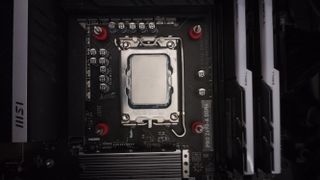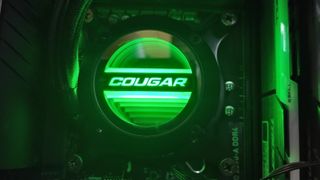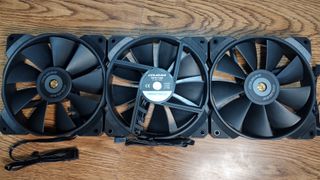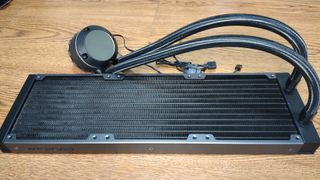Tom's Hardware Verdict
Cougar’s Poseidon GT 360 is the best performing AIO I’ve tested thus far. Just keep your power limits at 200W (or less).
Pros
- +
Best cooler tested thus far when limited to 200W or less
- +
Clickable hardware ARGB controller
Cons
- -
Fans aren’t the quietest
- -
No lighting/fan control software
Why you can trust Tom's Hardware
German company Cougar, founded in 2007, has a lineup that includes many peripherals, from CPU coolers to keyboards, and even gaming chairs. While companies like Noctua are known for their “plain” brown colors, Cougar is known for having orange accents in many of its products, and especially for its orange fans (although you won’t find one here).
We have Cougar’s Poseidon GT 360 on our test bench, an AIO Liquid Cooler which features a 360mm radiator. Is the GT 360 capable of taming Intel’s Core i9-12900K and earning a spot on our best CPU coolers list? We’ll have to put it through testing to find out, but first here are the specifications, direct from Cougar. The Poseidon GT 630 is currently available in Canada for $149.99. It’s also available in Australia and Taiwan and should be available in other regions soon.
Specifications for the Cougar Poseidon GT 360
| Cooler | Cougar Poseidon GT 360 |
| MSRP | $149.99 CAD |
| Radiator Dimensions | 392 x 121 x 27mm |
| Socket Compatibility | Intel Socket LGA 115X / 1200 / 1366/ 1700 / 2011 / 2066 |
| AMD AM4 / AM5 / sTRX4 / sTR4 / FM1 / FM2 / AM2(+) / AM3(+) | |
| Rated Noise Level | Up to 34.5 dBa |
| Cold Plate Material | Copper |
| CPU Block Dimensions | 71.5 x 49.8 mm |
Packing and Included Contents
Cougar’s Poseidon GT 360 is packaged in a medium-sized, long box, with molded cardboard and soft coverings of the individual parts for protection.

Included with the package are the following:
- CPU Block + Radiator
- 3x Cougar MHP 120 fans
- Mounts for all modern CPU sockets, including LGA1700, TR4, and AM4/AM5 motherboards
- Thermal Paste
- Information Leaflet
- Fan Splitter
- ARGB Controller


Cooler Installation

Installing Cougar’s Poseidon GT 360 was simple enough. To begin, you’ll first want to secure the radiator to your case. Next, press the backplate against the motherboard and secure it using stand-offs and silicone pads.

Cougar doesn’t pre-install the thermal paste, but includes a small tube of thermal paste with the unit. After applying the thermal paste, press the CPU block against the standoffs, and then use the included thumb screws to secure it.

New Testing Configuration
| Cooler | Cougar Poseidon GT 360, 360mm AIO Liquid Cooler |
| Comparison Coolers Tested | BeQuiet Pure Loop 2 FX, 360mm AIO |
| Cooler Master Master Liquid PL360 Flux, 360mm AIO | |
| Cooler Master Master Liquid PL240 Flux, 240mm AIO | |
| Cougar Forza 85, Air Cooler | |
| Corsair iCUE H100i Elite, 240mm AIO | |
| DeepCool AK500, Air Cooler | |
| DeepCool LS520, 240mm AIO | |
| DeepCool LS320, 120mm AIO | |
| Thermalright Peerless Assassin 120 SE | |
| CPU | Intel i9-12900K |
| Motherboard | MSI z690 A-Pro DDR4 |
| Case | BeQuiet! Silent Base 802 Window |
| PSU | DeepCool PQ1000M |
What's different than other coolers?
CPU block with ARGB Lighting & Rotatable Infinity Mirror

The CPU block has ARGB lighting support and an “Infinity Mirror” with Cougar’s logo which can be adjusted to any position you desire. This means you can install the pump in any rotation without the logo being in an odd orientation.

Hardware ARGB Controller

Some coolers on the market require the use of proprietary software in order to change lighting settings. Cougar’s Poseidon doesn’t have software, which means you’ll generally need to use either your motherboard’s BIOS controls to change lighting options or download a tool such as OpenRGB or SignalRGB in order to make adjustments. However, Cougar includes a SATA-powered hardware ARGB controller which allows you to change ARGB settings, quite literally with the click of a button.
Cougar MHP 120 Fans

There’s more to a liquid cooler than just the radiator and pump. The fans included have a significant impact on cooling and performance. Included with the Poseidon GT 360 are three Cougar MHP 120 fans, which have a solid black color and high static pressure. These fans don’t support ARGB lighting, a choice we felt was odd, considering the CPU block does have RBG lighting.
| Model | MHP 120 |
| Dimensions | 120 x 120 x 25 mm |
| Fan Speed | 600-2000RPM ±200RPM |
| Air Flow | 82.48 CFM |
| Air Pressure | 4.24 mmH2O |
| Noise Level | Up to 34.5 dB(A) |
| Lighting | None |
Radiator with “UTTERIGHT” Fins Design

Many radiators use fins with curved endings – but not Cougar’s Poseidon AIOs. Instead, Cougar uses “UTTERIGHT” fins, which are shaped at a right angle. Cougar states that this design allows for greater heat transfer area and increased cooling efficiency in comparison to more common fins designs.
Testing Configuration
I'll be testing Cougar’s Poseidon GT 360 with Intel's Core i9-12900K, paired with an MSI Z690 A PRO DDR4 motherboard and Be Quiet’s Silent Base 802 casease. Due to the increased thermal density of the Intel 7 manufacturing process, as well as changes to core and component layouts, Alder Lake CPUs are more difficult to cool than previous generation CPUs in the most heat-intensive of workloads.
This means that coolers that kept previous generation products like the i9-10900K nice and cool sometimes struggle to keep Intel's i9-12900K under Tj max–the top temperature before the CPU starts to throttle. Many coolers I’ve tested have failed to keep the i9-12900K under TJ max when power limits are removed in workloads like Cinebench and OCCT. We’ll find out before long how this compares to AMD’s latest Ryzen 7000 CPUs, which also have higher TDPs than previous-gen chips.
Please note there are many factors other than the CPU cooler that can influence your cooling performance. A system's motherboard can especially influence this, as there are motherboards on the market with CPU sockets that aren't up to Intel's spec, which can cause warping or poor contact with the CPU. The case you use will also influence cooling results.
With Alder Lake's cooling demands in mind, I'll be rating CPU Coolers in 3 different tiers.
Tier 1: These coolers are able to keep the i9-12900K below TJ max in most loads, with no power limits enforced. I expect only the best liquid coolers to meet this standard.
Tier 2: These coolers are able to keep the i9-12900K under the TJ max threshold with CPU power limits of 200W enforced. I expect most liquid coolers and the best air coolers to meet this standard.
Tier 3: These coolers are able to keep the i9-12900K under TJ max with CPU power limits of 140W enforced.
Testing Methodology
To test the limits of a cooler's thermal dissipation capabilities, I run two primary stress tests: Cinebench and OCCT, each for 10 minutes. While this may be a short amount of time, it is sufficient to push most coolers - air and liquid - to their limits.
While stress testing in Cinebench, I run both with power limits removed and with an enforced 200W CPU power limit. In this test setup using MSI’s Z690 A Pro DDR4 Motherboard and Be Quiet’s Silent Base 802 Computer Case, only the best coolers are able to pass Cinebench testing when power limits are removed.
I don’t test OCCT without power limits because attempting to do so results in CPU package power consumption jumping to over 270W and instantly throttling with even the best AIO coolers. Instead, I test at 200W to give coolers a chance at passing. I’ve also included 140W results to give data comparable to a CPU that doesn’t use as much power, such as AMD’s Ryzen 5800x or Intel’s i5-12600K.
- MORE: Best CPU Coolers
- MORE: Raptor Lake All We Know
- MORE: How to check CPU Temperature

Albert Thomas is a contributor for Tom’s Hardware, primarily covering CPU cooling reviews.

Sabrent debuts 5GB/s Rocket Nano 2242 Gen 4 SSD — a good fit for Lenovo Legion Go, laptops, and NUCs

AMD takes CPU market share from Intel in desktops and servers, but Intel fights back in laptops

Stack Overflow bans users en masse for rebelling against OpenAI partnership — users banned for deleting answers to prevent them being used to train ChatGPT
-
SyCoREAPER Cheaping out with no real RGB control is a deal breaker. Unlike most, I don't care for unicorn puke or bright LEDsReply -
Albert.Thomas ReplyFoeke said:Now compare it with the real Germans at Alphacool. Cougar is more of a sticker company.
I would love to test Alphacool's products, I used them for cooling my RX Vega GPU and it did wonders! -
Roberto Gomez In which store in the United States do they sell cooling? I can't find it anywhereReply
